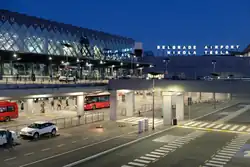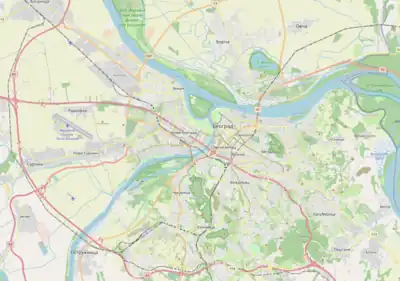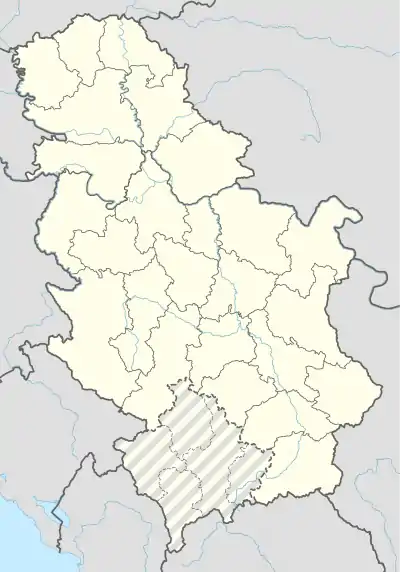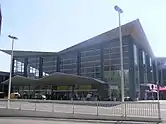Belgrade Nikola Tesla Airport Аеродром Никола Тесла Београд Aerodrom Nikola Tesla Beograd | |||||||||||||||
|---|---|---|---|---|---|---|---|---|---|---|---|---|---|---|---|
 | |||||||||||||||
 | |||||||||||||||
| Summary | |||||||||||||||
| Airport type | International | ||||||||||||||
| Owner | Government of Serbia | ||||||||||||||
| Operator | VINCI Airports Serbia d.o.o.[1] | ||||||||||||||
| Serves | Belgrade | ||||||||||||||
| Location | Belgrade, Serbia | ||||||||||||||
| Hub for | |||||||||||||||
| Elevation AMSL | 336 ft / 102 m | ||||||||||||||
| Coordinates | 44°49′10″N 20°18′25″E / 44.81944°N 20.30694°E | ||||||||||||||
| Website | beg.aero | ||||||||||||||
| Map | |||||||||||||||
 BEG Location within Belgrade  BEG BEG (Serbia) | |||||||||||||||
| Runways | |||||||||||||||
| |||||||||||||||
| Statistics (2022) | |||||||||||||||
| |||||||||||||||
Source: Vinci Airports Press Release[2] | |||||||||||||||
 | |
Native name | Аеродром Никола Тесла Београд |
|---|---|
| Type | Joint-stock company |
| BELEX: AERO | |
| Industry | Airport operations |
| Founded | 28 April 1962 |
| Headquarters | Aerodrom Beograd 47, Surčin, , |
Area served | Belgrade, Serbia |
Key people | Saša Vlaisavljević (CEO) Vesna Stanković Jevđević (Chairman of the Supervisory Board) |
| Revenue | |
| Total assets | |
| Total equity | |
| Owner | Government of Serbia (84.56%) Others [4] |
Number of employees | 1,556 (2018) |
| Parent | Vinci Airports |
| Footnotes / references Business ID: 07036540 Tax ID: 100000539[5] | |
Belgrade Nikola Tesla Airport (Serbian: Аеродром Никола Тесла Београд / Aerodrom Nikola Tesla Beograd) or Belgrade Airport (Serbian: Аеродром Београд / Aerodrom Beograd) (IATA: BEG, ICAO: LYBE) is an international airport serving Belgrade, Serbia. It is the largest and the busiest airport in Serbia, situated 18 km (11 mi) west of downtown Belgrade near the suburb of Surčin, surrounded by fertile lowlands. It is operated by French conglomerate Vinci Airports and it is named after Serbian-American inventor Nikola Tesla (1856–1943).
The flag carrier and the largest airline of Serbia, Air Serbia, uses Belgrade Nikola Tesla as their hub. It is also one of the many operating bases for low-cost airline Wizz Air. The air taxi services Air Pink, Eagle Express and Prince Aviation also call the airport their home.
History
First airfields
The first airfield in Belgrade was inaugurated in 1910 in the neighbourhood of Banjica and was initially used by aviation pioneers such as Simon, Maslenikov, Vidmar and Čermak. Two years later a wooden hangar was built for the Serbian Air Force, which was at the time engaged in the First Balkan War against Turkey. In 1914, the Banjica airfield was the base for the Serbian Air Force squadron and the Balloon Company. After the end of the First World War, the Banjica airfield was used for airmail traffic and included the routes Novi Sad–Belgrade–Niš–Skoplje and Belgrade–Sarajevo–Mostar.[6]
In 1911 another airfield was inaugurated in Belgrade, in the lower city of the Kalemegdan Fortress at the location of today's Belgrade Planetarium.[6]
Airport in Pančevo
An airport on the outskirts of Pančevo, a town located northeast of Belgrade, began its operations in 1923 when CFRNA inaugurated the international route Paris–Istanbul, which was flown via Belgrade. It was on that route that same year that the first world night flight ever happened in history.[7] The same year airmail service began operating from the airport. The Pančevo airport was also used by the Royal Yugoslav Air Force academy. After the World War II the airport was used by the Yugoslav Air Force before it became the airfield of the Utva Aviation Industry after its relocation from Zemun to Pančevo.[6]
Airport in Dojno Polje (New Belgrade)
Because of the distance from Pančevo to downtown Belgrade, which at that time required crossing the Danube, a decision was made to build a new airport that would be closer. The airport was planned to be built just across the river Sava, in a neighborhood today known as Novi Beograd. It was opened on 25 March 1927 under the official name of Belgrade International Airport (also known as Dojno polje Airport). From February 1928, the aircraft owned by the first local airline Aeroput started taking off from the new airport. The airport had four 1,100–2,900 metres (3,610–9,510 ft) long grass runways. The design for a reinforced concrete hangar that was built at the airfield was made by the Serbian scientist Milutin Milanković, better known for his theory of climate change. A modern terminal building was built in 1931, while the landing equipment for conditions of poor visibility was installed in 1936.[6]
Before World War II, Belgrade was also used as a stopover for some major air races, such as The Schlesinger African Air Race.[8]
Besides Aeroput, Air France, Deutsche Luft Hansa, KLM, Imperial Airways and airlines from Italy, Austria, Hungary, Romania and Poland also used the airport until the outbreak of the Second World War. Belgrade gained further prominence when Imperial Airways introduced inter-continental routes through Belgrade, when London was linked with India through the airport.[9] Belgrade was linked with Paris and Breslau because CIDNA and Deutsche Luft Hansa, respectively, included Belgrade on its routes to Istanbul.[10] By 1931, Belgrade became a major air hub being linked with regular flights with international destinations such as London, Madrid, Venice, Brussels, Berlin, Cologne, Warsaw, Prague, Vienna, Graz, Klagenfurt, Budapest, Bucharest, Sofia, Varna, Thessaloniki, Athens, Istanbul, and also intercontinental links with Cairo, Karachi and India.[9]
Starting from April 1941, German occupation forces used the airport. During 1944 it was bombed by the Allies, and in October of the same year the German army destroyed the remaining facilities while withdrawing from the country.[6]
The airport was rebuilt by October 1944 and until the end of the war was used by the Soviet Union and Yugoslavia as part of the Allied war effort.[6]
Civil transport by Yugoslav Air Force cargo planes from this airport was reinstated at the end of 1945. At the beginning of 1947 JAT Yugoslav Airlines and JUSTA took over domestic and international traffic, and from 1948 Western European airlines resumed flights to Belgrade.[6]
A constant increase in traffic and the beginning of the passenger jet era called for a significant expansion of the airport. In the meantime, a plan to build a residential and business district called Novi Beograd on the location of the airport was introduced. The officials decided therefore that a new international airport should be built near the village of Surčin to the west. The last flight to depart from the old airport was early in 1964.[11]
Airport in Surčin
The new location for the airport was on the Surčin plateau, 15 km (9 mi) from Belgrade's city centre.[11] Thanks to the original planners' vision, two conditions for the airport's development were fulfilled: a location was chosen that met the navigational, meteorological, construction, technical, and traffic requirements; and the special needs for the airport's long-term development were established.
Building of the new airport started in April 1958 and lasted until 28 April 1962, when it was officially opened by President Josip Broz Tito.[11] During that period a 3,000-metre-long (1.9 mi) runway was built, with the parallel taxiway and concrete aprons for sixteen airplanes. The passenger terminal building occupied an area of 8,000 m2 (86,000 sq ft). Cargo storage spaces were also built, as well as a technical block with the air-traffic control tower and other accompanying facilities. Modern navigational equipment was installed, earning the airport the highest international classification according to the International Civil Aviation Organization.[12]
The airport stagnated during the 1990s after the outbreak of the Yugoslav wars and the United Nations sanctions imposed on the Serbia and Montenegro. The sanctions also included a ban on air travel. The airport had minimal passenger movement, and many facilities were in need of reparation.
With a change in government and international sentiment, normal air traffic resumed in 2001. A few years later the airport's terminal 2 underwent a major reconstruction. The runway was upgraded to CAT IIIb in 2005, as part of a large renovation project. CAT IIIb is an Instrument Landing System (ILS), giving aircraft the security of landing during fog and storms. In 2006, the airport was renamed to Belgrade Nikola Tesla Airport. Nikola Tesla was a Serbian-American inventor and scientist, generally considered one of the world's most famous inventors.[13] The construction of the new air traffic control centre was completed in 2010. In 2011 Belgrade Nikola Tesla Airport shares (AERO) began trading on the Belgrade Stock Exchange (BELEX).
2012–2018
In 2012, construction work on the modernization and expansion of the airport began. It was carried out on the expansion and reconstruction of the A-gate and C-gate departure and transit areas. As a result, an extra 2,750 square metres (29,600 sq ft) was added. Jetways at the A and C gates were also replaced.
Also, there were plans for the construction of a new control tower as the current air control tower was built in 1962.[14] Future expansion of current terminals should see additional 17,000 sqm added, with terminal 2 getting additional 4 jetways.[15]
2018–present
In January 2018, the Government of Serbia granted a 25-year concession of the Belgrade Nikola Tesla Airport to the French airport operator Vinci Airports for a sum of 501 million euros.[16] On 21 December 2018, Vinci formally took over the airport.[17] In 2018, the airport had a sizeable increase in revenue and net income, due to Vinci Airports transaction.[18]
Terminals
The airport's two terminals have a combined area of 44,000 sqm, with Terminal 2 being larger of the two, the two terminals are connected by a hallway.[19] The airport has 90[20] check-in counters and 32[21] gates (of which 24 are equipped with jetways). Gates A1-A10 and C1-C14 are equipped with jetways, gates A7a, A7b and C10a-C10e use buses, while gate A11 is used for domestic flights to Niš.
Terminal 1
Terminal 1 (T1) was the original and only terminal when the airport was built. The terminal handled domestic flights during the time of Yugoslavia and Serbia and Montenegro, and subsequently has come to be used for international flights, mostly by low-cost and charter airlines. The terminal went through a major renovation in 2016 and 2017 when the interior was overhauled.[22]
Terminal 2
Terminal 2 (T2) was constructed in 1979 for the airport's growing passenger numbers. The terminal has a capacity of 5 million passengers.[23] The terminal contains airline offices, transfer desks and various retail shops. The terminal went through two major renovations: from 2004 through 2006, with the arrivals and departures areas of the terminal completely reconstructed, and another one in 2012 and 2013 when there were works on expansion and overhaul of the C platform. While not officially confirmed, it is believed that the overhauled T1 will be used by foreign carriers, while Air Serbia and Etihad Airways Partners would gain exclusive use of Terminal 2.[24]





Airlines and destinations
Passenger
The following airlines operate regular scheduled and charter flights as of December 2023:[25][26]
Cargo
The following cargo airlines served the airport on a regular basis:[42]
| Airlines | Destinations |
|---|---|
| Cargoair | Linz[42] |
| DHL Aviation | Leipzig/Halle, Milan-Malpensa[42] |
| Turkish Cargo | Istanbul[42] |
Statistics
Traffic figures
| Year | Passengers | Change | Cargo (t) | Change | Aircraft movements | Change |
|---|---|---|---|---|---|---|
| 2002 | 1,621,798 | 6,827 | 28,872 | |||
| 2003 | 1,849,148 | 6,532 | 32,484 | |||
| 2004 | 2,045,282 | 8,946 | 36,416 | |||
| 2005 | 2,032,357 | 7,728 | 37,614 | |||
| 2006 | 2,222,445 | 8,200 | 42,360 | |||
| 2007 | 2,512,890 | 7,926 | 43,448 | |||
| 2008[43] | 2,650,048 | 8,129 | 44,454 | |||
| 2009[44] | 2,384,077 | 6,690 | 40,664 | |||
| 2010[45] | 2,698,730 | 7,427 | 44,160 | |||
| 2011[46] | 3,124,633 | 8,025 | 44,923 | |||
| 2012[47] | 3,363,919 | 7,253 | 44,990 | |||
| 2013[48] | 3,543,194 | 7,679 | 46,828 | |||
| 2014[49] | 4,638,577 | 10,222 | 58,695 | |||
| 2015[50] | 4,776,110 | 13,091 | 58,506 | |||
| 2016[51] | 4,924,992 | 13,939 | 58,633 | |||
| 2017[52] | 5,343,420 | 22,350 | 58,859 | |||
| 2018[53] | 5,641,105 | 25,543 | 67,460 | |||
| 2019 [54] | 6,159,000 | N/A | N/A | 70,365 | ||
| 2020[55] | 1,904,025 | N/A | N/A | 34,452 | ||
| 2021[56] | 3,286,295 | N/A | N/A | 48,842 | ||
| 2022[57] | 5,611,920 | N/A | N/A | 65,644 | ||
| 2023 (Jan-Nov)[58] | 7,310,778 | N/A | N/A | N/A | N/A | |
Passenger numbers
| Month | Passengers | Change (2018–2019) | Passengers Cumulatively |
|---|---|---|---|
| January | 347,544 | 347,544 | |
| February | 315,717 | 663,261 | |
| March | 372,122 | 1,035,383 | |
| April | 467,469 | 1,502,852 | |
| May | 507,633 | 2,010,485 | |
| June | 602,466 | 2,612,951 | |
| July | 734,898 | 3,347,849 | |
| August | 757,062 | 4,104,911 | |
| September | 647,005 | 4,751,916 | |
| October | 562,996 | 5,314,912 | |
| November | 424,656 | 5,739,568 | |
| December | 419,432 | 6,159,000 | |
| Month | Passengers | Change (2023–2019) | Change (2023-2022) | Passengers Cumulatively |
|---|---|---|---|---|
| January | 445,840 | 445,840 | ||
| February | 396,091 | 841,931 | ||
| March | 471,518 | 1,313,449 | ||
| April | 579,094 | 1,892,543 | ||
| May | 648,748 | 2,541,291 | ||
| June | 745,467 | 3,286,758 | ||
| July | 901,843 | 4,188,601 | ||
| August | 930,536 | 5,119,137 | ||
| September | 833,155 | 5,952,292 | ||
| October | 744,022 | 6,696,314 | ||
| November | 614,464 | 7,310,778 | ||
| December | — | — | — | — |
Busiest routes
Services
Security
Before the 2020/2021-2023 remodelling, Belgrade Nikola Tesla Airport was built with only one airside hallway for both departing and arriving passengers. As such, security checks used to be located at gate entrances rather than on a central location. As of 2021, however, there is a central security hall directly above the ticketing area, before passport control, where all passengers must be screened.
Passport controls are placed on two entrances and the single exit of the hallway. All passengers must pass the passport control, except those traveling domestically. An additional security check used to exist on the hallway entrance, but it was removed in 2013 as it inconvenienced passengers and was not essential for security.[63]
In 2007 the airport prohibited cars parking next to the airport terminal, instead they have to use the car park provided, as a result of the 2007 Glasgow International Airport attack.[64]
Lounges
Source:[65]
Belgrade Nikola Tesla Airport offers a single business class lounge, Business Club, for all airlines operating from the airport. "Business Club", opened in 2011, covers an area of 250 m2 (2,700 sq ft), and can seat 30 guests.
The airport also has a VIP lounge, with separate check-in and passport control facilities - also used by general aviation customers. The lounge consists of three parts - the first part for leisure, second for television crew and press conferences and a third part is a presidential suite. The lounge has a total surface area of 500 m2 (5,400 sq ft). The lounge is also used as a press centre, upon the arrival of VIPs.
Air Serbia Premium Lounge is the first dedicated airline owned and operated lounge at the airport. It is open from 5 am 8pm every day for Air Serbia/Etihad Airways business class passengers, as well as members of the Air Serbia/Etihad Guest frequent flyer program and other passengers who purchase one time lounge access.
Ground transport
Car
The airport is connected to the A3 motorway via a nearby interchange. The toll station on A3 is located to the west of the interchange, and the sections to the Belgrade downtown and the Belgrade bypass are toll-free. Licensed taxis from the airport to the city are available.
Bus
The following scheduled bus services connect the airport with its surroundings:[66][67]
| Service | Destination (departing from the airport) |
|---|---|
| Line A1 | Slavija Square (view on the map) |
| Line 72 | Zeleni Venac (view on the map) |
| Line 600 | Belgrade Centre railway station (view on the map) |
| Line 607 | Banovo Brdo (view on the map) |
| Line 860i | Savski Square (view on the map)/Barič (view on the map) |
Rail
The Serbian Ministry of Construction, Transportation and Infrastructure has announced a construction project for a new railway line between the city and the airport. The construction is scheduled to start in 2024, and should be completed in 18 months.[68]
See also
References
- ↑ Belgrade Nikola Tesla Airport – About the Concession www.beg.aero (in English and Serbian)
- ↑ "VINCI Airports – Traffic 2022" (PDF).
- ↑ "Претрага привредних друштава". apr.gov.rs (in Serbian). Retrieved 25 July 2022.
- 1 2 3 4 5 "Godisnji izvestaj za 2021. godinu" (PDF). antb.rs (in Serbian). Retrieved 20 April 2023.
- ↑ "Error" Основни подаци о привредном друштву. apr.gov.rs (in Serbian). Serbian Business Registers Agency. Retrieved 23 March 2022.
- 1 2 3 4 5 6 7 Belgrade Nikola Tesla Airport. "History: International Belgrade Airport (1927)". Archived from the original on 5 October 2007. Retrieved 24 July 2007.
- ↑ "The story of JAT: the best and the worst of Balkan air travel". 31 July 2012. Retrieved 20 April 2022.
- ↑ "ENGLAND TO AFRICA". The Mercury. 21 September 1936. p. 4. Retrieved 24 December 2022.
- 1 2 "World Airlines Directory". Flight International. 8 May 1931. p. 407.
- ↑ International Air Guide: Air Atlas: The Reference Book on Civil and Commercial Aviation. Imprimerie Crété S.A. 2017. p. 431. ISBN 978-1-5430-2191-2.
- 1 2 3 Nikolić, Jovan (8 May 2007). "Svi Beogradski aerodromi" (in Serbian). Glas javnosti. Retrieved 24 July 2007.
- ↑ Belgrade Nikola Tesla Airport. "History: Belgrade Surcin (1962)". Retrieved 4 April 2007.
- ↑ "Aerodrom menja ime u "Nikola Tesla"". B92 (in Serbian). 2 February 2006. Archived from the original on 13 March 2007. Retrieved 4 April 2007.
- ↑ "Rovčanin: Novi kontrolni tornjevi u Beogradu i Tivtu" (in Serbian). Tanjug. 1 October 2014.
- ↑ "Prve ilustracije: Novi izgled "C" hodnika aerodroma "Nikola Tesla" - Tango Six". Tangosix.rs. 4 August 2015. Retrieved 16 May 2018.
- ↑ "Pala odluka: Kome će "Nikola Tesla"". b92.net (in Serbian). Tanjug. 5 January 2018. Retrieved 6 January 2018.
- ↑ "Vansi preuzeo aerodrom Nikola Tesla". Radio Free Europe (in Serbian). 21 December 2018. Retrieved 22 December 2018.
- ↑ Obradović, M. (16 July 2019). "Otpisi dugova i isplata koncesije napumpali profit". danas.rs (in Serbian). Retrieved 10 August 2019.
- ↑ "Construction works at BEG".
- ↑ "BEG check-in counters" (PDF).
- ↑ "BEG gates" (PDF).
- ↑ "PHOTOS: Belgrade Airport overhaul". EX-YU Aviation News. 22 May 2017. Retrieved 16 May 2018.
- ↑ I.R. (15 May 2006). "Vrata za pet miliona putnika godišnje" (in Serbian). Danas. Archived from the original on 1 April 2012. Retrieved 4 April 2007.
- ↑ "EX-YU Aviation News". EX-YU Aviation News. Retrieved 16 May 2018.
- ↑ "Timetable :: Belgrade Nikola Tesla Airport". Beg.aero. Archived from the original on 15 September 2018. Retrieved 16 May 2018.
- ↑ "Air Serbia Charter Operations". Air Serbia. Archived from the original on 29 April 2021.
- 1 2 "Aegean to launch two new Belgrade routes". exyuaviation.com. 26 October 2021. Retrieved 26 October 2021.
- ↑ "Air Serbia schedules Chicago launch". 17 November 2022.
- ↑ https://www.airserbia.com/en/footer_menu/corporate/news/news?id=1176
- ↑ "Air Serbia 1Q24 Suspended Routes Summary – 21DEC23". AeroRoutes. 23 December 2023. Retrieved 23 December 2023.
- ↑ "Air Serbia to launch three weekly Mostar flights". AeroRoutes. 10 January 2024. Retrieved 10 January 2024.
- ↑ "Air Serbia to grow charter traffic by 15%". exyuaviation.com. 1 June 2023.
- ↑ "Air Serbia to run regular Mersa Matruh charters". 12 May 2023.
- ↑ "airBaltic to launch new Serbia, Croatia and Montenegro flights". 29 September 2022.
- ↑ "AnadoluJet to launch new Belgrade service". 12 November 2023.
- ↑ "AnadoluJet pushes back new Belgrade service". 6 February 2023.
- ↑ "British Airways to launch Belgrade service". 2 August 2023. Retrieved 3 August 2023.
- ↑ "Eurowings to launch new Belgrade service". 10 December 2021.
- ↑ "Kuwait's Jazeera Airways launching Belgrade flights". www.exyuaviation.com. 30 January 2023.
- ↑ "Belgrade Airport in talks with several carriers as recovery continues". 15 April 2022.
- 1 2 3 4 5 "Wizz Air to base fourth jet in Belgrade, launch five new routes". 22 December 2022.
- 1 2 3 4 "Cargo Flights Timetable :: Belgrade Nikola Tesla Airport". Beg.aero. Archived from the original on 26 September 2017. Retrieved 16 May 2018.
- ↑ "BEG 2008". 12 January 2009.
- ↑ "BEG 2009". 17 January 2010.
- ↑ "BEG 2010". 10 January 2012.
- ↑ "BEG 2011". 10 January 2012.
- ↑ "BEG 2012". 18 January 2013.
- ↑ "BEG 2013". 2 February 2014.
- ↑ "BEG 2014". 22 January 2015.
- ↑ "BEG 2015". 15 January 2016.
- ↑ "BEG 2016". 19 January 2017.
- ↑ "BEG 2017". 18 January 2018.
- ↑ "BEG 2018". 22 January 2019.
- ↑ "Belgrade Airport readies for transformation after record year". Ex Yu Aviation. 18 January 2020. Retrieved 18 January 2020.
- ↑ "BEG 2020". 22 July 2020.
- ↑ "BEG 2021". 18 January 2022.
- ↑ "BEG 2022". exyuaviation.com. January 2023. Retrieved 13 January 2023.
- ↑ "BEG 2023". October 2023. Retrieved 14 November 2023.
- ↑ "Belgrade Airport (BEG)". www.belgrade-airport.com. Retrieved 23 March 2023.
- 1 2 "Добро дошли на Аеродром Никола Тесла Београд | Аеродром Никола Тесла Београд". beg.aero (in Serbian). Retrieved 23 March 2023.
- ↑ "Belgrade 2023". 14 December 2023.
- ↑ "Live Flight Tracker - Real-Time Flight Tracker Map".
- ↑ "Samo jedna kontrola na aerodromu" [Only one control on the Airport]. RTS. 20 May 2013.
- ↑ Mondo WEB Portal (14 August 2007). "Zabranjen saobraćaj ispred zgrade aerodroma" (in Serbian). Archived from the original on 27 September 2007. Retrieved 8 August 2007.
- ↑ "Airport Lounges". Belgrade Airport. 23 March 2023.
- ↑ beg.aero - Public transportation retrieved 9 December 2023
- ↑ bgprevoz.rs - Public transportation retrieved 9 December 2023
- ↑ "Serbia to build Belgrade Airport rail link". exyuaviation.com. 5 June 2018. Archived from the original on 25 February 2021. Retrieved 24 December 2022.
External links
![]() Media related to Belgrade Nikola Tesla Airport at Wikimedia Commons
Media related to Belgrade Nikola Tesla Airport at Wikimedia Commons
